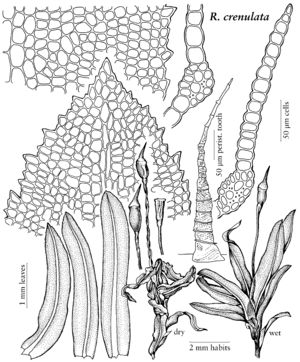Difference between revisions of "Rhabdoweisia crenulata"
Rev. Bryol. 17: 6. 1890,.
Basionym: Didymodon crenulatus Mitten
FNA>Volume Importer |
FNA>Volume Importer |
||
| Line 50: | Line 50: | ||
|publication year= | |publication year= | ||
|special status= | |special status= | ||
| − | |source xml=https://jpend@bitbucket.org/aafc-mbb/fna-data-curation.git/src/ | + | |source xml=https://jpend@bitbucket.org/aafc-mbb/fna-data-curation.git/src/8f726806613d60c220dc4493de13607dd3150896/coarse_grained_fna_xml/V27/V27_612.xml |
|genus=Rhabdoweisia | |genus=Rhabdoweisia | ||
|species=Rhabdoweisia crenulata | |species=Rhabdoweisia crenulata | ||
Revision as of 16:56, 18 September 2019
Plants 0.5–3 cm. Leaves lingulate, crisped when dry, 2–4 mm, broadly acute to obtuse, margins irregularly dentate distally, distal cells 14–20 µm wide, irregularly hexagonal, rather thin-walled. Seta 3–4 mm. Capsule 0.6–1 mm; peristome teeth narrowly lanceolate to subulate, smooth to faintly striolate, to 500 µm. Spores 18–20 µm.
Phenology: Capsules mature summer.
Habitat: Wet, shaded ledge
Elevation: moderate elevations (ca. 1100 m)
Distribution
N.C., Europe, Asia, Pacific Islands (Hawaii).
Discussion
Of conservation concern.
On the North American continent, this species is known from a single locality in the Appalachian Mountains (R. H. Zander 1966).
Selected References
None.
Lower Taxa
None.
